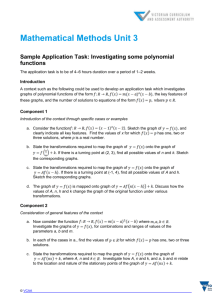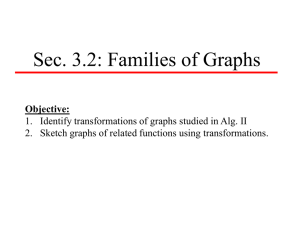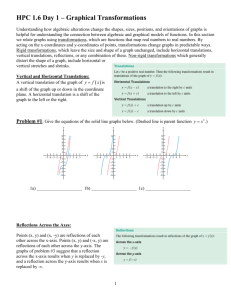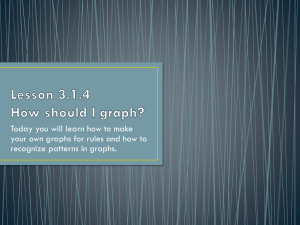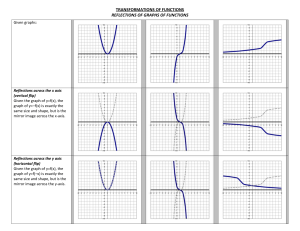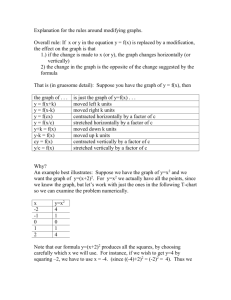Chapter 1-4 Student
advertisement
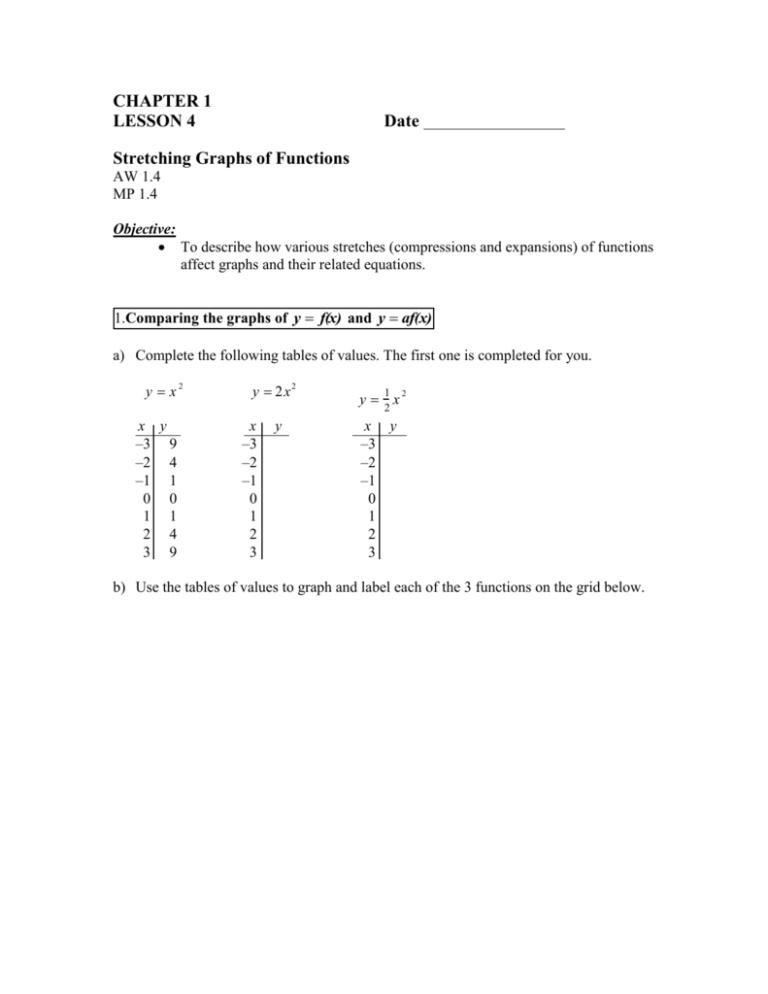
CHAPTER 1 LESSON 4 Date Stretching Graphs of Functions AW 1.4 MP 1.4 Objective: To describe how various stretches (compressions and expansions) of functions affect graphs and their related equations. 1.Comparing the graphs of y f(x) and y af(x) a) Complete the following tables of values. The first one is completed for you. y x2 x y –3 9 –2 4 –1 1 0 0 1 1 2 4 3 9 y 2x 2 x –3 –2 –1 0 1 2 3 y 1 y 2x 2 x y –3 –2 –1 0 1 2 3 b) Use the tables of values to graph and label each of the 3 functions on the grid below. 2 c) How can each of the following graphs be obtained from the graph of y x ? 2 i) y 2x 1 2 ii) y 2 x 2 2 d) In general, how is the graph of y ax obtained from the graph of y x i) when a 1? ii) when 0 a 1 ? Summary: • If a 1, the graph of y af (x) is obtained when the graph of y f (x) undergoes a _______________ __________________ by a factor of a. • If 0 a 1, the graph of y af (x) is obtained when the graph of y f (x) undergoes a _______________ __________________ by a factor of a. Remember that the y–values of y af (x) are obtained by multiplying each y–value of y f (x) by the factor a. What happens if a 0? In general, if a 0 , the graph of y af (x) is obtained when the graph of y f (x) undergoes a _____________________________ by a factor of a, along with a _________________________________________. Note: y f (x) is often used instead of y af (x) to emphasize that the a parameter a involves a stretch in the y–direction: i.e., a vertical stretch. The notation Example 1: Sketch the graph of y 3 x . We can obtain the graph of y 3 x from the graph of y x through two transformations: a) _____________________________________________________ b) ______________________________________________________ 2.Comparing the graphs of y f(x) and y f(ax) a) Complete the following tables of values. The first one is completed for you. y x x 16 9 4 1 0 y 4 3 2 1 0 y (2x ) x 8 4.5 2 0.5 0 y y (0.5x ) x 32 18 8 2 0 y b) Use the tables of values to graph and label each of the 3 functions on the grid below. c) How can each of the following graphs be obtained from the graph of y x ? i) y (2x ) ii) y (0.5x ) d) In general, how is the graph of y (bx) obtained from the graph of y x i) when b 1? ii) when 0 b 1 ? Summary: • If b 1, the graph of y f (bx) is obtained when the graph of y f (x) undergoes a ________________ _________________ by a factor of . • If 0 b 1, the graph of y f (bx) is obtained when the graph of y f (x) undergoes a _____________ __________________ by a factor of . Notice from your tables that for y (2x ) to have the same y–values as y x , the corresponding x–values of y (2x ) must be divided by the factor 2. Thus in general, for y f (bx) to have the same y–values as y f (x) , the corresponding x–values of y f (bx) must be divided by the factor b. In other words, if b 1, it takes “less x” to do the job of building the function y f (bx) , so we have a horizontal compression of y f (x) . Also, if 0 b 1, it takes “more x” to do the job of building the function y f (bx) , so we have a horizontal expansion of y f (x) . What happens if b 0? In general, if b 0, the graph of y f (bx) is obtained when the graph of y f (x) 1 undergoes a ________ _______ ____________________ by a factor of b , along with a __________________________________________. Example 2: The grid below contains the graph of a function y f (x) . Sketch the graph of 1 y f ( 3 x) . 3. Combined Vertical and Horizontal Stretches y The function y af (bx) [or a f (bx) ] can be obtained by stretching the function y f (x) according to the following rules. If a 1, there is a vertical expansion by a factor of a. If 0 a 1, there is a vertical compression by a factor of a. If a 0 there is also a reflection in the x–axis. 1 If b 1, there is a horizontal compression by a factor of b . 1 If 0 b 1, there is a horizontal expansion by a factor of b . If b 0, there is also a reflection in the y–axis. Example 3: How is the graph of 5y 2x related to the graph of y x ? Example 4: 2 The graph of y 9 x is shown below. 2 Sketch the graph of 2y 9 x . Example 5: The graph of a function y f (x) is expanded vertically by a factor of 3, compressed 1 horizontally by a factor of 4 , and then reflected in the y–axis. If the equation of its image is y af (bx) , determine the values of a and b for the transformation. Example 6: The graph of y f (x) is shown. Sketch the graph of y 2 f ( 12 x) on the same grid. Example 7: 1 Describe the transformations whereby the function y 4 f ( 5 x ) is obtained from the function y f (x) . Example 8: 2 The graph of y 9 x is shown below. Write the equation for each of the following graphs that are transformations of y 9 x2 . Example 9: In each case, write the equation of the mapping that results after the given transformation. 3 A) y x has been vertically translated 5 units up. 3 B) y x has been expanded vertically by a factor of 5. 1 3 C) y x has been compressed vertically by a factor of 5 . 1 3 D) y x has been compressed horizontally by a factor of 5 .

